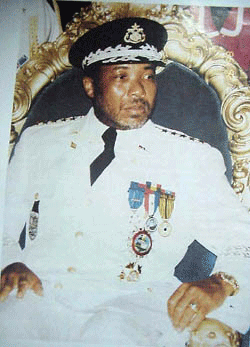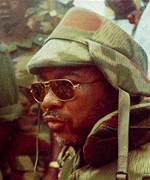
The Perspective
Atlanta, Georgia
March 28, 2006
 |
|
Charles Taylor
|
Back then, Mr. Taylor was spending hundreds of thousands of dollars on Public Relations, buying spreads in the Washington Post at the cost of half a million dollars when the staff at the Embassy had not received salary for months and there was no electricity at the Liberian Mission near the UN in New York. Tiawan Gongloe and Hassan Billity were among the lucky ones for surviving the torture and death chambers of the ATU.
Now, four years later, the dynamics have changed and unless something absolutely absurd were to happen to Nigeria, Liberia and Sierra Leone, Mr. Charles McArthur Ghankay Taylor, former president of the Republic of Liberia, chief of all Zoes and Supreme Leader of the Masonic Order, will find his way into a small jail cell, somewhere in Freetown, Sierra Leone to answer to accusations libeled against him by the United Nations Special War Crime Tribunal.
The walls have closed in on Mr. Charles Taylor. The man who broke out of a Massachusetts jail while awaiting transfer to Liberia in 1984, and found his way to West Africa, and later turned up in Libya at the head of a group of fighters from the sub-region recruited mostly in Accra and Abidjan to launch a rebellion to unseat the military dictatorship of Samuel K. Doe, will, after all, face what he has eluded all along: a court of justice.
 |
|
Charles Taylor
|
Arrogance led the president of Liberia to continue his attempts to subjugate the entire region. He had his eyes on Cote d’Ivoire, beyond the Cavalla River. He was planning to go after Laurent Gbagbo who has chased his friend Robert Guei from high jacking power after fraudulent elections. He wanted to get rid of Lansanah Conteh in Guinea, who, in 1992, said that unless ECOWAS got rid him, Mr. Taylor would continue to grow like a cancer and destroy the sub-region. But most of all, he wanted to get his hands on the diamonds of Sierra Leone. There was never any doubt in Liberia about the linkages between Mr. Taylor and the Revolutionary United Front (RUF) of Sierra Leone, led by Sergeant Foday Sankoh.
The RUF trained in Libya with the National Patriotic Front of Liberia (NPFL). Once they entered Liberia, the two groups operated as a team. The RUF had headquarters in Danane and operated in the same training camps as the NPFL. RUF fighters brought diamonds from Sierra Leone and got arms and munitions in exchange. When the international community imposed on Sierra Leone the Liberia-styled government of inclusion, it was no surprise that RUF took the mining sector under its control. It was a pay-off for Mr. Taylor’s war efforts. But the massacre of civilians, the rapes of children, the forced labor never stopped. And this is what Mr. Taylor has been indicted for.
Mr. Taylor can consider himself a lucky man to be called to face a war Crimes Tribunal led by the United Nations and Sierra Leone rather to answer to crimes he perpetuated against his own people in Liberia. He may have to face that tribunal too, some day.
President Ellen Johnson Sirleaf took a big security gamble by asking Nigeria to “allow” Mr. Taylor to face the tribunal in Sierra Leone. Mr. Taylor still has a big following in Liberia. Many who carried out some of his deadliest actions are parading the streets of Monrovia, riding the most expensive cars while others are in the legislature or in many positions in the government. Some of his economic accomplices have found their way in the new power structure of President Sirleaf and like reptiles, they adapted to the new climate. The connection of these men and women to Mr. Taylor, in the logic of criminality is still strong. They fear that Mr. Taylor would drag them with him into the abyss just as he pulled them up from poverty. Keeping Mr. Taylor in his sinecure of Calabar would have also meant keeping a Damocles sword over Liberia, with the possibility of the return of the gang leader. Sending him to face the Court is, by all accounts, the lesser of two evils. It is the safest risk to take, in closing the chapter of the war.
It is rather ironic that Mr. Taylor would go to jail in Freetown, where President Joseph Momoh had locked him up in the 1980s when he went to Sierra Leone in his first attempt to invade Liberia, before the Ivorians allowed him to use their territory as a launching pad. Destiny has come full circle for him. If he escapes the indictment in Sierra Leone, the US Federal judicial system could ask for him to answer to a judge in Massachusetts for breaking jail. And who knows what Liberians may ask him to account for. With a bit of sobriety, Mr. Taylor could have still been president of Liberia, well into his second tenure, a real depressing possibility.
Liberians must come to terms with the fact that this is the end of the Taylor saga and that for the first time in 15 years they can put this name in a wastebasket and move on. Parents must not allow their children to be used as cannon fodders against innocent people again. No matter what comes out of Freetown, Mr. Taylor would fade in oblivion and those who want to tie their future to his fate would learn that Liberia is on its way to a new era, without them. Dealing with the Taylor issue is probably the first great test of national reconciliation. Can Liberians start to look at each other as friends, neighbors and compatriots without interposing the shadow of Mr. Taylor between them?